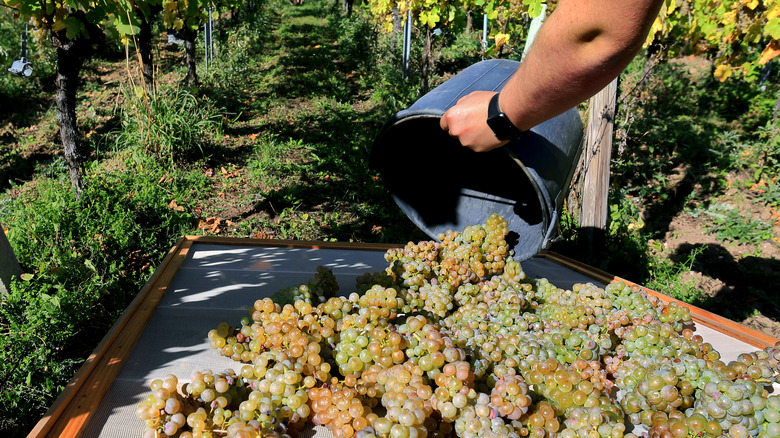The Reason Sweet Wine Uses An Astounding Amount Of Grapes
Wine's variance and complexity come as no surprise; it boasts an expansive possibility of flavor. All the variables that go into winemaking — like the thousands of grape varieties, fermentation practices, terroir, cellaring, and more — are difficult to keep up with. An even less considered factor in the mix is the volume of grapes that go into a bottle.
The amount typically varies from 2.75 to 3.3 pounds, although, as it goes with wine production, deviations are frequent. And especially for sweet wine varieties, the magnitude of packed-in grapes can be astounding. For example, expressions from Canada's Inniskillin winery utilize 72 pounds of fruit in a 375-milliliter bottle, while more classic ice wines such as Riesling and Gewurztraminer utilize just shy of 20 pounds for a full bottle. Why such a weight of grapes for an offering? It mainly comes down to the fact sweet wines utilize grapes with less water content, which lends to distinct fermentation and flavor. Let's dive into the details.
Sweet wines utilize grapes with a much smaller water content
With so much variety in both grape varietal and production, not every sweet wine necessitates more fruit for the same reason. Styles such as Hungary's Tokaji Aszú, Germany-Austrian Trockenbeerenauslese, and France's Sauternes all need more due to a process called botrytization. The fruit becomes purposefully infected with a noble rot fungus, which, under special seasonal conditions, yields an intensely sweet and complex grape juice. However, it also shrivels the fruit up in the process, which means it'll take a whole lot more flesh to generate a batch.
Picking the grape at a lower water content is also the reason for ice wine's lower yield, albeit without the infection. Such grapes are left on the vine late into the season and allowed to freeze. Then, they're juiced while still frozen, lending a more concentrated flavor since the ice crystals aren't pressed. Combined with the already lower water concentration at which they're picked, this means a whole lot more fruit goes into a batch. Yet, sample such a sweet wine done right, and all the extra exertion becomes evident. The style is sweet yet complex, with a quality wholly unique and delicious.

